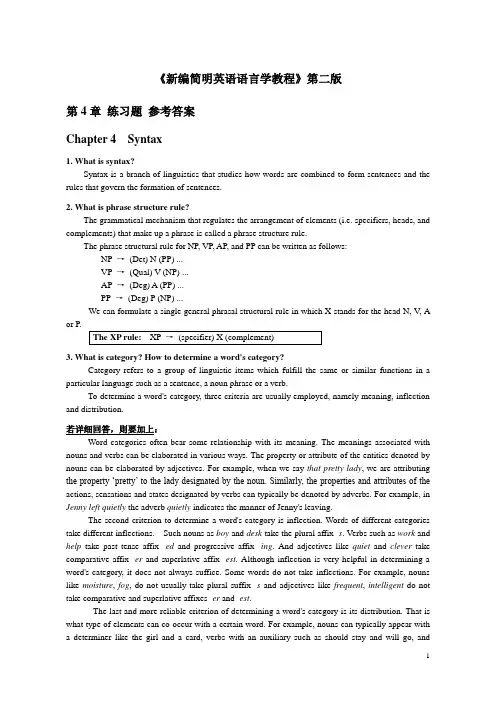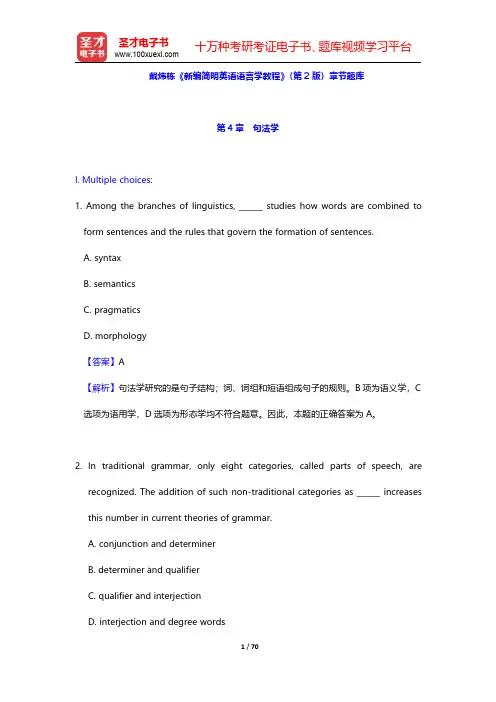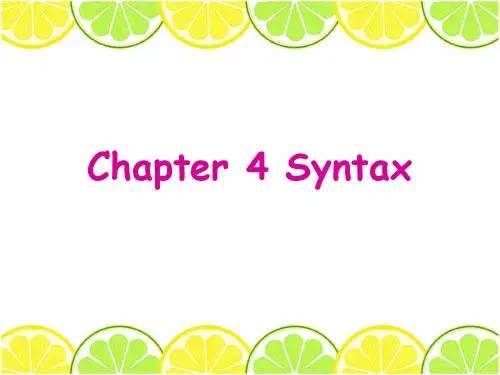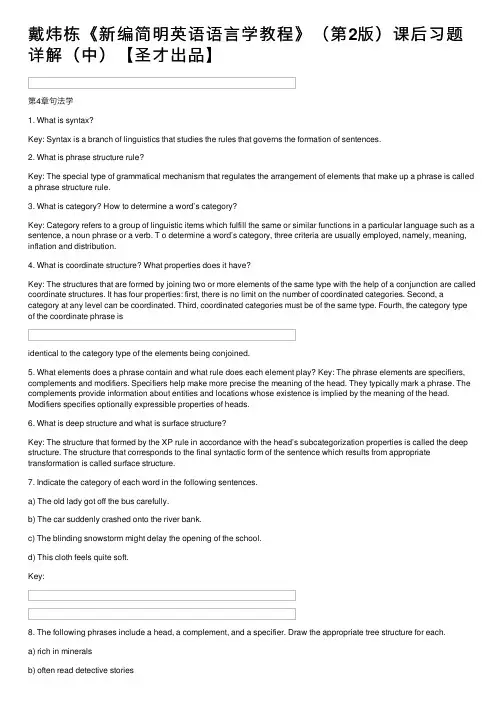新编简明英语语言学教程 第二版 戴炜栋4 Syntax
《语言学》Chapter 4 Syntax 习题兼答案

《新编简明英语语言学教程》第二版第4章练习题参考答案Chapter 4 Syntax1. What is syntax?Syntax is a branch of linguistics that studies how words are combined to form sentences and the rules that govern the formation of sentences.2. What is phrase structure rule?The grammatical mechanism that regulates the arrangement of elements (i.e. specifiers, heads, and complements) that make up a phrase is called a phrase structure rule.The phrase structural rule for NP, VP, AP, and PP can be written as follows:NP →(Det) N (PP) ...VP →(Qual) V (NP) ...AP →(Deg) A (PP) ...PP →(Deg) P (NP) ...We can formulate a single general phrasal structural rule in which X stands for the head N, V, A or P.3. What is category? How to determine a word's category?Category refers to a group of linguistic items which fulfill the same or similar functions in a particular language such as a sentence, a noun phrase or a verb.To determine a word's category, three criteria are usually employed, namely meaning, inflection and distribution.若详细回答,则要加上:Word categories often bear some relationship with its meaning. The meanings associated with nouns and verbs can be elaborated in various ways. The property or attribute of the entities denoted by nouns can be elaborated by adjectives. For example, when we say that pretty lady, we are attributing the property ‘pretty’ to the lady designated by the noun. Similarly, the properties and attributes of the actions, sensations and states designated by verbs can typically be denoted by adverbs. For example, in Jenny left quietly the adverb quietly indicates the manner of Jenny's leaving.The second criterion to determine a word's category is inflection. Words of different categories take different inflections. Such nouns as boy and desk take the plural affix -s. Verbs such as work and help take past tense affix -ed and progressive affix -ing. And adjectives like quiet and clever take comparative affix -er and superlative affix -est. Although inflection is very helpful in determining a word's category, it does not always suffice. Some words do not take inflections. For example, nouns like moisture, fog, do not usually take plural suffix -s and adjectives like frequent, intelligent do not take comparative and superlative affixes -er and -est.The last and more reliable criterion of determining a word's category is its distribution. That is what type of elements can co-occur with a certain word. For example, nouns can typically appear with a determiner like the girl and a card, verbs with an auxiliary such as should stay and will go, andadjectives with a degree word such as very cool and too bright.A word's distributional facts together with information about its meaning and inflectional capabilities help identify its syntactic category.4. What is coordinate structure and what properties does it have?The structure formed by joining two or more elements of the same type with the help of a conjunction is called coordinate structures.It has (或写Conjunction exhibits) four important properties:1) There is no limit on the number of coordinated categories that can appear prior to the conjunction.2) A category at any level (a head or an entire XP) can be coordinated.3) Coordinated categories must be of the same type.4) The category type of the coordinate phrase is identical to the category type of the elements beingconjoined.5. What elements does a phrase contain and what role does each element play?A phrase usually contains the following elements: head, specifier and complement. Sometimes it also contains another kind of element termed modifier.The role each element can play:Head:Head is the word around which a phrase is formed.Specifier:Specifier has both special semantic and syntactic roles. Semantically, it helps to make more precise the meaning of the head. Syntactically, it typically marks a phrase boundary.Complement:Complements are themselves phrases and provide information about entities and locations whose existence is implied by the meaning of the head.Modifier:Modifiers specify optionally expressible properties of the heads.6. What is deep structure and what is surface structure?There are two levels of syntactic structure. The first, formed by the XP rule in accordance with the head's subcategorization properties, is called deep structure(or D-structure). The second, corresponding to the final syntactic form of the sentence which results from appropriate transformations, is called surface structure (or S-structure).(以下几题只作初步的的成分划分,未画树形图, 仅供参考)7. Indicate the category of each word in the following sentences.a) The old lady got off the bus carefully.Det A N V P Det N Advb) The car suddenly crashed onto the river bank.Det N Adv V P Det Nc) The blinding snowstorm might delay the opening of the schools.Det A N Aux V Det N P Det Nd) This cloth feels quite soft.Det N V Deg A8. The following phrases include a head, a complement, and a specifier. Draw the appropriatetree structure for each.a) rich in mineralsXP(AP) →head (rich) A + complement (in minerals) PPb) often read detective storiesXP(VP) →specifier (often) Qual +head (read) V +complement (detective stories) NPc) the argument against the proposalsXP(NP) →specifier (the) Det +head (argument) N +complement (against the proposals) PP d) already above the windowXP(VP) →specifier (already) Deg +head (above) P +complement (the window) NPd) The apple might hit the man.S →NP (The apple) + Infl (might) +VP (hit the man)e) He often reads detective stories.S →NP (He) +VP (often reads detective stories)9. The following sentences contain modifiers of various types. For each sentence, first identify the modifier(s), then draw the tree structures.(斜体的为名词的修饰语,划底线的为动词的修饰语)a) A crippled passenger landed the airplane with extreme caution.b) A huge moon hung in the black sky.c) The man examined his car carefully yesterday.d) A wooden hut near the lake collapsed in the storm.10. The following sentences all contain conjoined categories. Draw a tree structure for each of the sentences.(划底线的为并列的范畴)a) Jim has washed the dirty shirts and pants.b) Helen put on her clothes and went out.c) Mary is fond of literature but tired of statistics.11. The following sentences all contain embedded clauses that function as complements of a verb, an adjective, a preposition or a noun. Draw a tree structure for each sentence.a) You know that I hate war.b) Gerry believes the fact that Anna flunked the English exam.c) Chris was happy that his father bought him a Rolls-Royce.d) The children argued over whether bats had wings.12. Each of the following sentences contains a relative clause. Draw the deep structure and the surface structure trees for each of these sentences.a) The essay that he wrote was excellent.b) Herbert bought a house that she lovedc) The girl whom he adores majors in linguistics.13. The derivations of the following sentences involve the inversion transformation. Give the deep structure and the surface structure of each of these sentences. (斜体的为深层结构,普通字体的为表层结构)a) Would you come tomorrow?you would come tomorrowb) What did Helen bring to the party?Helen brought what to the partyc) Who broke the window?who broke the window。
chapter 4 syntax 简明英语语言学 戴炜栋

3.3 IC Analysis (直接成分分析法) immediate constituent(直接成分)
Constituent (构成成分) ultimate constituent (最终成分)
IC(直接成分): Can be further segmented until we obtain the smallest grammatical units. UC(最终成分): The smallest grammatical unit obtained through segmentation.
2.2.1 Concord/agreement(一致关系)
A verb is to agree with the subject in person and in number. In English, this rule only affects the verb according to the number of the subject.
This principle refers to the rule that the verb can sometimes agree with the subject according to the notion of number rather than to the actual presence of the grammatical marker for that notion. e.g The government have asked the country to decide by a vote The new military government does not have popular support.
subject subject
戴炜栋《新编简明英语语言学教程》(第2版)章节题库(第4~6章)【圣才出品】

戴炜栋《新编简明英语语言学教程》(第2版)章节题库第4章句法学I.Multiple choices:1.Among the branches of linguistics,______studies how words are combined to form sentences and the rules that govern the formation of sentences.A.syntaxB.semanticsC.pragmaticsD.morphology【答案】A【解析】句法学研究的是句子结构;词、词组和短语组成句子的规则。
B项为语义学,C 选项为语用学,D选项为形态学均不符合题意。
因此,本题的正确答案为A。
2.In traditional grammar,only eight categories,called parts of speech,arerecognized.The addition of such non-traditional categories as______increases this number in current theories of grammar.A.conjunction and determinerB.determiner and qualifierC.qualifier and interjectionD.interjection and degree words【答案】B【解析】传统语法只承认8种范畴,称为词类,分别为名词、动词、形容词、介词、副词、冠词、连词、代词,但当今的语法理论增加了一些非传统的范畴,如:限定词determiner、程度词degree word和修饰词qualifier。
因此,本题的正确答案为B。
3.Which of the following is NOT the element that phrases formed of more than one word usually contain?A.Head.B.Specifier.C.Word category.plement.【答案】C【解析】由多个单词构成的短语通常包括:中心语、标志语和补语。
chapter syntax 简明英语语言学 戴炜栋

1) Grammatical concord(语法一致原则)
This principle refers to the rule that the verb must match its subject in number.
Fifteen miles seems like a long walk to me. Fifty-six dollars was stolen from the cash register.
3) Principle of Proximity(就近原则)
This principle denotes agreement of the verb with a closely preceding noun phrase. (there be, or, either…or, neither…nor, not only… but also, whether … or … ) e.g There is a pen, a few envelops and some paper for you.
Chapter 4 Syntax
1.What is syntax?
• A branch of linguistics that studies how words are combined to form sentences and the rules that govern the formation of sentences.
Either my brothers or my father is coming. Not only you but also he is wrong. Neither Tom nor I am a student.
戴炜栋《新编简明英语语言学教程》(第2版)课后习题详解(中)【圣才出品】

戴炜栋《新编简明英语语⾔学教程》(第2版)课后习题详解(中)【圣才出品】第4章句法学1. What is syntax?Key: Syntax is a branch of linguistics that studies the rules that governs the formation of sentences.2. What is phrase structure rule?Key: The special type of grammatical mechanism that regulates the arrangement of elements that make up a phrase is calleda phrase structure rule.3. What is category? How to determine a word’s category?Key: Category refers to a group of linguistic items which fulfill the same or similar functions in a particular language such as a sentence, a noun phrase or a verb. T o determine a word’s category, three criteria are usually employed, namely, meaning, inflation and distribution.4. What is coordinate structure? What properties does it have?Key: The structures that are formed by joining two or more elements of the same type with the help of a conjunction are called coordinate structures. It has four properties: first, there is no limit on the number of coordinated categories. Second, a category at any level can be coordinated. Third, coordinated categories must be of the same type. Fourth, the category type of the coordinate phrase isidentical to the category type of the elements being conjoined.5. What elements does a phrase contain and what rule does each element play? Key: The phrase elements are specifiers, complements and modifiers. Specifiers help make more precise the meaning of the head. They typically mark a phrase. The complements provide information about entities and locations whose existence is implied by the meaning of the head. Modifiers specifies optionally expressible properties of heads.6. What is deep structure and what is surface structure?Key: The structure that formed by the XP rule in accordance with the head’s subcategorization properties is called the deep structure. The structure that corresponds to the final syntactic form of the sentence which results from appropriate transformation is called surface structure.7. Indicate the category of each word in the following sentences.a) The old lady got off the bus carefully.b) The car suddenly crashed onto the river bank.c) The blinding snowstorm might delay the opening of the school.d) This cloth feels quite soft.Key:8. The following phrases include a head, a complement, and a specifier. Draw the appropriate tree structure for each.a) rich in mineralsb) often read detective storiesc) an augment against the proposalsd) already above the windowKey: a) rich in mineralsb) often read detective storiesc) the argument against the proposalsd) already above the window9. The following sentences contain modifiers of various types. For each sentence, first identify the modifier(s), then draw the tree structures.a) A crippled passenger landed the airplane with extreme caution.b) A huge moon hung in the black sky.c) The man examined his car carefully yesterday.d) A wooden hut near the lake collapsed in the storm.Key: (The modifiers are represented by italics.)a) A crippled passenger landed the airplane with extreme caution.b) A huge moon hung in the black sky.c) The man examined his car carefully yesterday.d) A wooden hut near the lake collapsed in the storm.10. The following sentences all contain conjoined categories. Draw a tree structure for each of the sentences.a) Jim has washed the dirty shirts and pants.b) Helen put on her clothes and went out.c) Mary is fond of literature but tired of statistics.Key: a) Jim has washed the dirty shirts and pants.b) Helen put on her clothes and went out.c) Mary is fond of literature but tired of statistics.11. The following sentences all contain embedded clauses that function ascomplements of a verb, an adjective, a preposition or a noun. Draw a tree structure for each sentence.a) You know that I hate war.b) Gerry can’t believe the fact that Anna flunked the English exam.c) Chris was happy that his father bought him a Rolls-Royce.d) The children argued over whether bats had wings.Key: a) You know that I hate war.。
圣才教育:戴炜栋《新编简明英语语言学教程》

内容摘要
实用性:这本书不仅注重理论知识的学习,还强调实际应用能力的培养。每一章节都附有大量实 例和案例分析,帮助学生更好地理解和掌握语言学知识。书中的关键词和思考题也为学生提供了 实际应用的指导。 时代性:这本书的内容紧跟时代步伐,反映了当今语言学研究的前沿。它不仅介绍了最新的语言 学理论和研究成果,还涉及了语言与文化、社会、认知等领域的交叉研究,有助于学生拓宽视野, 了解学科前沿。 内容丰富:这本书涵盖了语言学的各个方面,包括语音、词汇、语法、语义、语用等基础理论知 识和应用。同时,它还涉及了二语习得和语言习得的理论和实践,使得学生能够全面了解语言学 及应用。
该章节介绍了计算机与语言的、计算机与自然语言处理的关系以及自然语言处 理的基本任务和应用领域。
该章节介绍了认知科学的定义、认知科学的学科交叉性、语言与认知的关系以 及认知语言学的定义和基本原理。
该章节介绍了隐喻和转喻的定义、隐喻和转喻的认知功能以及隐喻和转喻在英 语词汇和表达中的应用。
该章节介绍了文化的定义、文化与语言的关系以及文化适应和文化休克的概念。 同时,还介绍了跨文化交际能力和跨文化意识的培养方法。
精彩摘录
语言是人类最重要的交际工具,是音义结合的符号系统。
语言的音和义、语素和词汇的意义是约定俗成的,语言的音义之间没有必然的 关系。
语言的底层是一套音位和音位的组合规则;上层是音义结合的语言符号。
语言具有创造性,它能够产生并理解无限量的语句。
语言具有创造性,它能够产生并理解无限量的语句。
该章节介绍了形态学的定义、词素和词根、词干和词缀、屈折变化和派生变化、 复合词和短语以及形态学在自然语言处理中的应用。
该章节介绍了句法学的定义、语法和句法的关系、短语、句子和句法结构、句 法规则的类型和应用、转换语法和句法分析的基本原则以及句法学在自然语言 处理中的应用。
06422英语语言学—新编简明英语语言学教程,戴炜栋
06422英语语言学—新编简明英语语言学教程,戴炜栋06422英语语言学—新编简明英语语言学教程, 戴炜栋ContentsChapter 1 Introduction (1)Chapter 2 Phonology (5)Chapter 3 Morphology (8)Chapter 4 Syntax (9)Chapter 5 Semantics (12)Chapter 6 Pragmatics (16)Chapter 7 Historical linguistics (19)Chapter 8 Sociolinguistics (24)Chapter 9 Psycholinguistics (29)Chapter 10 Language Acquisition (32)Chapter 1 Introduction一、定义1.语言学LinguisticsLinguistics is generally defined as the scientific study of language.2.普通语言学General LinguisticsThe study of language as a whole is often called General linguistics.3.语言languageLanguage is a system of arbitrary vocal symbols used for human communication.语言是人类用来交际的任意性的有声符号体系。
4.识别特征Design FeaturesIt refers to the defining properties of human language that distinguish it from any animal system of communication.语言识别特征是指人类语言区别与其他任何动物的交际体系的限定性特征。
戴炜栋《新编简明英语语言学教程》(第2版)课后习题详解(第4章 句法学——第6章 语用学)【圣才出品
第4章句法学1. What is syntax?Key: Syntax is a branch of linguistics that studies the rules that governs the formation of sentences.2. What is phrase structure rule?Key: The special type of grammatical mechanism that regulates the arrangement of elements that make up a phrase is called a phrase structure rule.3. What is category? How to determine a word’s category?Key: Category refers to a group of linguistic items which fulfill the same or similar functions in a particular language such as a sentence, a noun phrase or a verb. T o determine a word’s category, three criteria are usually employed, namely, meaning, inflation and distribution.4. What is coordinate structure? What properties does it have?Key: The structures that are formed by joining two or more elements of the same type with the help of a conjunction are called coordinate structures. It has four properties: first, there is no limit on the number of coordinated categories. Second, a category at any level can be coordinated. Third, coordinated categories must be of the same type. Fourth, the category type of the coordinate phrase isidentical to the category type of the elements being conjoined.5. What elements does a phrase contain and what rule does each element play? Key: The phrase elements are specifiers, complements and modifiers. Specifiers help make more precise the meaning of the head. They typically mark a phrase. The complements provide information about entities and locations whose existence is implied by the meaning of the head. Modifiers specifies optionally expressible properties of heads.6. What is deep structure and what is surface structure?Key: The structure that formed by the XP rule in accordance with the head’s subcategorization properties is called the deep structure. The structure that corresponds to the final syntactic form of the sentence which results from appropriate transformation is called surface structure.7. Indicate the category of each word in the following sentences.a) The old lady got off the bus carefully.b) The car suddenly crashed onto the river bank.c) The blinding snowstorm might delay the opening of the school.d) This cloth feels quite soft.Key:8. The following phrases include a head, a complement, and a specifier. Draw the appropriate tree structure for each.a) rich in mineralsb) often read detective storiesc) an augment against the proposalsd) already above the windowKey: a) rich in mineralsb) often read detective storiesc) the argument against the proposalsd) already above the window9. The following sentences contain modifiers of various types. For each sentence, first identify the modifier(s), then draw the tree structures.a) A crippled passenger landed the airplane with extreme caution.b) A huge moon hung in the black sky.c) The man examined his car carefully yesterday.d) A wooden hut near the lake collapsed in the storm.Key: (The modifiers are represented by italics.)a) A crippled passenger landed the airplane with extreme caution.b) A huge moon hung in the black sky.c) The man examined his car carefully yesterday.d) A wooden hut near the lake collapsed in the storm.10. The following sentences all contain conjoined categories. Draw a tree structure for each of the sentences.a) Jim has washed the dirty shirts and pants.b) Helen put on her clothes and went out.c) Mary is fond of literature but tired of statistics.Key: a) Jim has washed the dirty shirts and pants.b) Helen put on her clothes and went out.c) Mary is fond of literature but tired of statistics.11. The following sentences all contain embedded clauses that function ascomplements of a verb, an adjective, a preposition or a noun. Draw a tree structure for each sentence.a) You know that I hate war.b) Gerry can’t believe the fact that Anna flunked the English exam.c) Chris was happy that his father bought him a Rolls-Royce.d) The children argued over whether bats had wings.Key: a) You know that I hate war.。
新编简明英语语言学教程 第二版 戴炜栋4 Syntax
Criteria on good grammar
Observational adequacy Descriptive adequacy Explanatory adequacy The ultimate goal for any theory is to explain. TG differs from traditional grammar in that it not only aims at language description, but also its explanation.
Chapter 4 Syntax
What is syntax?
----a branch of linguistics that studies how words are combined to form sentences and the rules that govern the formation of sentences.
Transformational Generative Grammar (TG) Norm. Chomsky, the most influential linguist in 20th century, some important works: (1957) Syntactic Structure; (1965) Aspects of the Theory of Syntax; (1981) Lectures on Government and Binding; (1986) Barriers (1993) A Minimalist Program for Linguistic Theory; (1995) The Minimalist Program; (1998) The Minimalist Inquiry……
新编简明英语语言学教程戴炜栋第1-3章课后练习题答案
《新编简明英语语言学教程》第二版第1-3章练习题参考答案Chapter 1 IntroductionP131. How do you interpret the following definition of linguistics: Linguistics is the scientific study of language ?答:Linguistics is based on the systematic investigation of linguistic data, conducted with reference to some general theory of language structure. In order to discover the nature and rules of the underlying language system, the linguists has to collect and observe language facts first, which are found to display some similarities, and generalizations are made about them; then he formulates some hypotheses about the language structure. The hypotheses thus formed have to be checked repeatedly against the observed facts to fully prove their validity. In linguistics, as in any other discipline, data and theory stand in a dialectical complementation, that is, a theory without the support of data can hardly claim validity, and data without being explained by some theory remain a muddled mass of things.2. What are the major branches of linguistics? What does each of them study?答: The major branches of linguistics are:(1) phonetics: it studies the sounds used in linguistic communication;(2) phonology: it studies how sounds are put together and used to convey meaning in communication;(3) morphology: it studies the way in which linguistic symbols representing sounds are arranged and combined to form words;(4) syntax: it studies the rules which govern how words are combined to form grammatically permissible sentences in languages;(5) semantics: it studies meaning conveyed by language;(6) pragmatics: it studies the meaning in the context of language use.3. In what basic ways does modern linguistics differ from traditional grammar?答: The general approach thus traditionally formed to the study of language over the years is roughly referred to as “ditional grammar. ” Modern linguistics differs from traditional grammar in several basic ways.Firstly, linguistics is descriptive while traditional grammar is prescriptive.Second, modem linguistics regards the spoken language as primary, not the written. Traditional grammarians, on the otherhand, tended to emphasize, maybe over-emphasize, the importance of the written word, partly because of its permanence.Then, modem linguistics differs from traditional grammar also in that it does not force languages into a Latin-based framework.4. Is modern linguistics mainly synchronic or diachronic? Why?答: In modem linguistics, a synchronic approach seems to enjoy priority over a diachronic one. Because people believed thatunless the various states of a language in different historical periods are successfully studied, it would be difficult to describe the changes that have taken place in its historical development.5. For what reasons does modern linguistics give priority to speech rather than to writing?答: Speech and writing are the two major media of linguistic communication. Modem linguistics regards the spoken languageas the natural or the primary medium of human language for some obvious reasons. From the point of view of linguistic evolution, speech is prior to writing. The writing system of any langu age is always a invented ” by its users to record speech when the need arises. Even in today's world there are still many languages that can only be spoken but not written. Then in everyday communication, speech plays a greater role than writing in terms of the amount of information conveyed. And also, speech is always the way in which every native speaker acquires his mother tongue, and writing is learned and taught later when he goes to school. For modern linguists, spoken language reveals many true features of human speech while written language is only the"revised ” record of spe. Thus their data for investigation and analysis are mostly drawn from everyday speech, which they regard as authentic.6. How is Saussure's distinction between langue and parole similar to Chomsky's distinction between competence and performance?答:Saussure's distinction and Chomsky's are very similar, they differ at least in that Saussuretook a sociological view of language and his notion of langue is a matter of social conventions, and Chomsky looks at language from a psychological point of view and to him competence is a property of the mind of each individual.7. What characteristics of language do you think should be included in a good, comprehensive definition of language? 答:First of all, language is a system, i.e., elements of language are combined according to rules.Second, language is arbitrary in the sense that there is no intrinsic connection between a linguistic symbol and what the symbol stands for.Third, language is vocal because the primary medium for all languages is sound.Fourth, language is human-specific, i. e., it is very different from the communication systems other forms of life possess.8. What are the main features of human language that have been specified by C. Hockett to show that it is essentially different from animal communication system? (2. 2 语言的识别性特征)美国语言学家 C. Hockett 提出了人类语言的12 种识别性特征,其中最重要的识别性特种有 5 种:即语言的任意性、创造性、二重性、移位性和文化传递性。
- 1、下载文档前请自行甄别文档内容的完整性,平台不提供额外的编辑、内容补充、找答案等附加服务。
- 2、"仅部分预览"的文档,不可在线预览部分如存在完整性等问题,可反馈申请退款(可完整预览的文档不适用该条件!)。
- 3、如文档侵犯您的权益,请联系客服反馈,我们会尽快为您处理(人工客服工作时间:9:00-18:30)。
Complements
---- Complements themselves can be a phrase, they provide information abut entities and locations whose existence is implied by the meaning of the head, e.g. a story about a sentimental girl. There can be no complement, one complement, or more than one complement in a phrase, e.g. p.48 (44)…(4-6) A sentence-like construction may also function as a complement such as in “I believed that she was innocent. I doubt if she will come. They are keen for you to show up.” “That/if /for” in the above sentences are complementizers(补语化成分), the clauses introduced by complementizers are complement clause.
Meaning: n. entities, v. action, adj. properties Ex. be aware of know about Inflection: n –s, v. –ed -ing, adj. –er -est Ex. a word belonging to more than one category Distribution: a/an n., be v-ed, be v-ing, Note: The most reliable criterion of determining a word’s category is its distrs and their structures
Phrase categories----the syntactic units that are built around a certain word category are called phrase categories, such as NP, VP, AP, PP. NP VP AP PP phrase level l l l l N V A P word level The structure: specifier + head + complement head(中心成分)---- the word around which a phrase is formed specifier(标志成分)---- the words on the left side of the heads complement (补足成分) ---- the words on the right side of the heads
Chomsky is much more interested in the similarities (language universals) between languages rather than their differences.
Linguists should attempt to find a grammatical framework which will be suitable for all languages; Linguists should concentrate on the elements and constructions that are available to all languages rather than on elements that actually occur in all languages. There are likely to be universal constraints on the ways linguistic elements are combined Chomsky proposed that the grammars of all human languages share a common framework (Universal Grammar).
S NP VP
S
NP Det A N boy V found VP NP Det the N evidence
Sentences (the S rule)
Chapter 4 Syntax
What is syntax?
----a branch of linguistics that studies how words are combined to form sentences and the rules that govern the formation of sentences.
Transformational Generative Grammar (TG) Norm. Chomsky, the most influential linguist in 20th century, some important works: (1957) Syntactic Structure; (1965) Aspects of the Theory of Syntax; (1981) Lectures on Government and Binding; (1986) Barriers (1993) A Minimalist Program for Linguistic Theory; (1995) The Minimalist Program; (1998) The Minimalist Inquiry……
Phrase elements
specifier (标志成分) head (中心成分) complement (补足成分)
specifiers
---- Semantically, specifiers make more precise the meaning of the head -----Syntactically, they typically mark a phrase boundary. Specifiers can be determiners as in NP, qualifiers as in VP and degree words as in AP.
The XP rule
XP
Specifier
X
Head
Complement
The XP rule: XP(specifier)X(complement) Note: The phrase structure rules can be summed up as XP rule shown in the diagram, in which X stands for N, V, A or P.
Coordination rule
Coordinate structures-----the structures that are formed by joining two or more elements of the same type with the help of a conjunction such as and, or, etc. ----Coordination has four important properties: no limit on the number of coordinated categories before the conjunction; a category at any level can be coordinated; the categories must be of the same type; the category type of the coordinate phrase is identical to the category type of the elements being conjoined.
Categories
Category(范畴)refers to a group of linguistic items which fulfill the same or similar functions in a particular language such as a sentence, a noun phrase or a verb. The most central categories to the syntactic study are the word-level categories (traditionally, parts of speech)
Phrase structure rules (PS-rule 段语结构规则)
The grammatical mechanism that regulates the arrangement of elements that make up a phrase is called a phrase structure rule, such as: NP (Det) + N +(PP)……e.g. those people, the fish on the plate, pretty girls. VP (Qual) + V + (NP)……e.g. always play games, finish assignments. AP (Deg) + A + (PP)……very handsome, very pessimistic, familiar with, very close to PP (Deg) + P + (NP)……on the shelf, in the boat, quite near the station.
